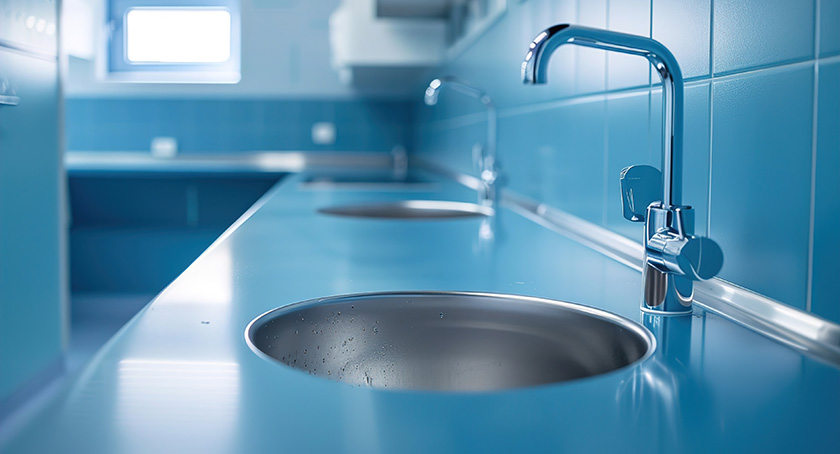The healthcare sector remains a major consumer of antimicrobial coatings.

Degimages/stockadobe.com
The global antimicrobial coatings market is projected to surpass $10.1 billion by 2032, driven by increasing awareness of hygiene and the rising demand for infection control in various sectors, including healthcare, food and beverage, and construction. This article delves into the key factors propelling the market, current trends, challenges, and future opportunities.
Market Dynamics
Growth Drivers
- Increased Demand in Healthcare: The healthcare sector remains a major consumer of antimicrobial coatings due to the necessity of maintaining sterile environments. Hospitals, clinics, and surgical centers are increasingly adopting these coatings on medical devices, surgical instruments, and facility surfaces to prevent the spread of healthcare-associated infections (HAIs). The recent COVID-19 pandemic further underscored the importance of stringent infection control measures, spurring demand for antimicrobial solutions.
- Rising Consumer Awareness: With growing awareness of the importance of hygiene and sanitation, consumers are increasingly opting for products with antimicrobial properties. This trend is evident in the household sector, where antimicrobial coatings are being applied to kitchen appliances, bathroom fixtures, and furniture to enhance cleanliness and safety.
- Applications in Food and Beverage Industry: The food and beverage industry is another significant growth driver. Antimicrobial coatings are used on food processing equipment, packaging, and storage facilities to inhibit microbial growth, thereby extending shelf life and ensuring food safety. This is particularly crucial given the stringent food safety regulations globally.
Current Trends
- Nanotechnology in Antimicrobial Coatings: The integration of nanotechnology in antimicrobial coatings has revolutionized the industry. Nanocoatings provide superior antimicrobial efficacy due to their larger surface area-to-volume ratio, which enhances the interaction with microbial cells. These coatings are being extensively researched and developed for various applications, including medical devices and consumer products.
- Eco-friendly Antimicrobial Coatings: Environmental sustainability is a growing concern, leading to the development of eco-friendly antimicrobial coatings. These coatings use biodegradable and non-toxic materials, reducing their environmental impact. The push towards green solutions is expected to drive significant innovations in this space.
- Smart Coatings: Smart antimicrobial coatings that respond to environmental stimuli, such as changes in temperature or humidity, are gaining traction. These coatings can release antimicrobial agents only when necessary, making them more efficient and extending their lifespan.
Challenges
- Regulatory Hurdles: The antimicrobial coatings market faces stringent regulatory scru tiny, particularly concerning safety and efficacy. Compliance with regulations such as the Environmental Protection Agency (EPA) in the U.S. and the Biocidal Products Regulation (BPR) in Europe can be challenging and time-consuming for manufacturers.
- High Costs: The production and application of antimicrobial coatings, especially those incorporating advanced technologies like nanotechnology, can be costly. This may limit their adoption, particularly in price-sensitive markets.
- Antimicrobial Resistance: There is a growing concern about antimicrobial resistance (AMR), where microorganisms develop resistance to antimicrobial agents. This can reduce the efficacy of antimicrobial coatings over time, necessitating continuous research and development to stay ahead of resistant strains.
Future Opportunities
- Expansion in Emerging Markets: Emerging economies, particularly in Asia-Pacific and Latin America, present significant growth opportunities. Rapid urbanization, rising healthcare infrastructure, and increasing disposable incomes in these regions are expected to drive demand for antimicrobial coatings.
- Technological Advancements: Continued advancements in material science and nanotechnology will likely result in more efficient and cost-effective antimicrobial coatings. Innovations such as self-cleaning surfaces and multi-functional coatings that combine antimicrobial properties with other benefits (e.g., anti-corrosive, anti-fouling) are expected to open new market avenues.
- Collaborations and Partnerships: Strategic collaborations between coating manufacturers, research institutions, and end-user industries can accelerate the development and adoption of antimicrobial coatings. Such partnerships can facilitate knowledge exchange, drive innovation, and enhance market penetration.
Conclusion
The antimicrobial coatings market is poised for robust growth, driven by heightened hygiene awareness and increasing demand across various sectors. While challenges such as regulatory compliance and high costs exist, the market's future looks promising with continuous technological advancements and expanding applications. By 2032, the market is expected to exceed USD 10.1 billion, reflecting the critical role of antimicrobial coatings in enhancing safety and hygiene standards globally.
Source: https://www.gminsights.com/industry-analysis/antimicrobial-coatings-market-report